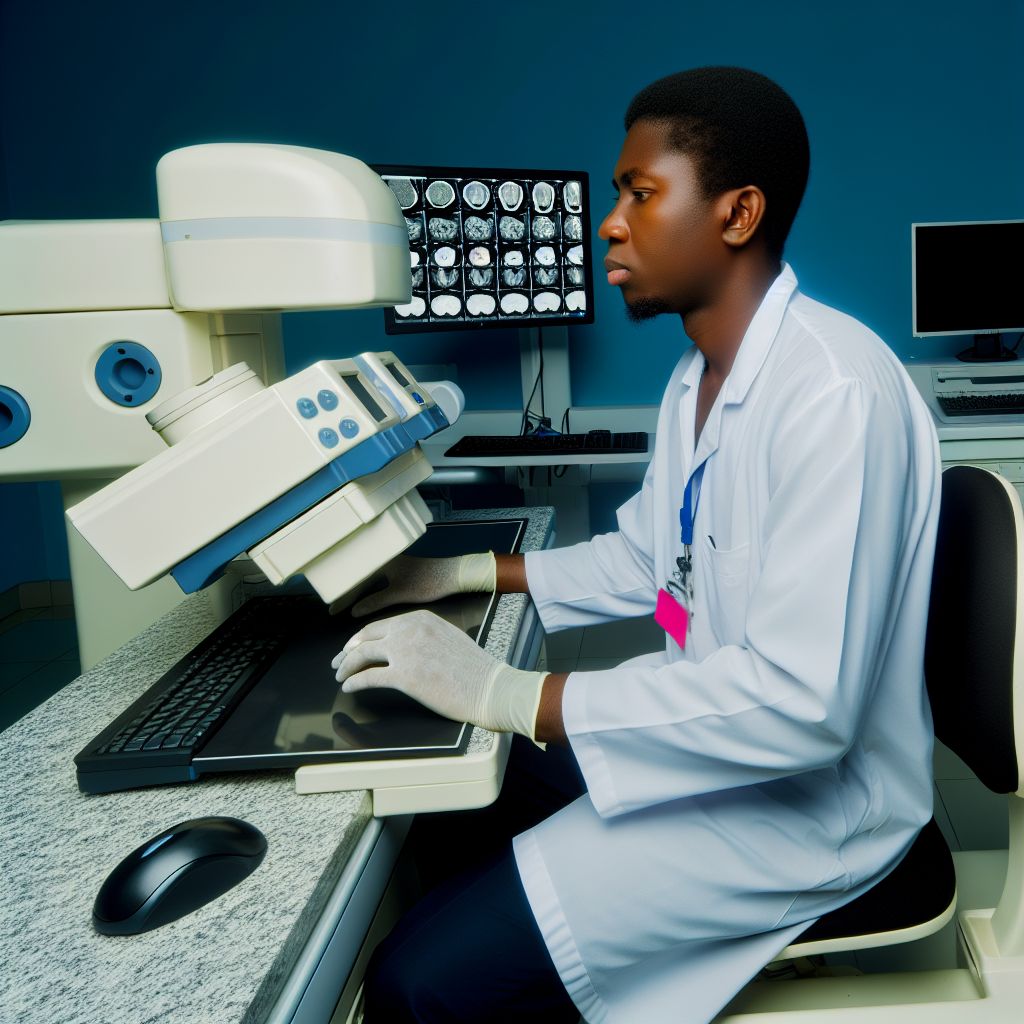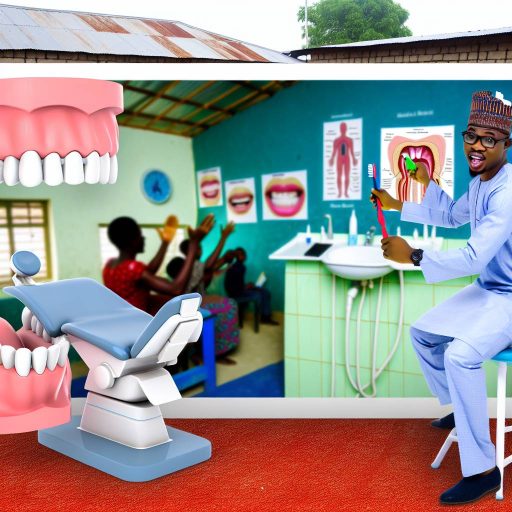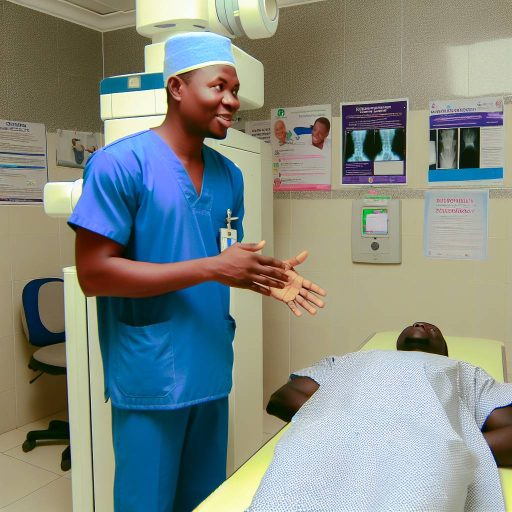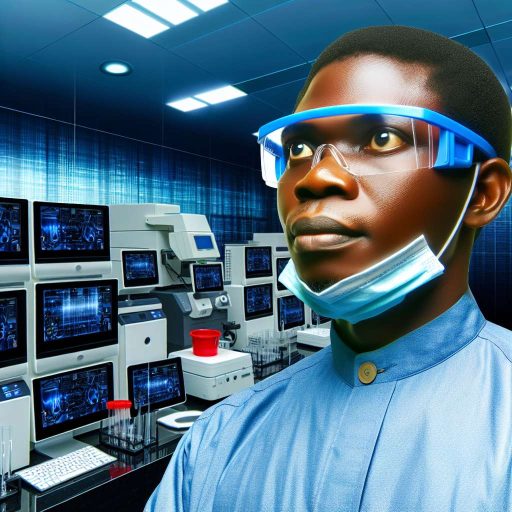Introduction
Radiography equipment plays a crucial role in the field of radiography.
It is essential for accurate diagnostic imaging.
Understanding this equipment is vital for Nigerian students studying radiography to ensure proficiency in the field.
As aspiring radiographers, having a comprehensive knowledge of radiography equipment is essential for successful diagnostic procedures.
Importance of Radiography Equipment
Having proper and up-to-date equipment in the field of radiography is crucial for several reasons.
- Accuracy of Diagnosis: High-quality equipment ensures precise imaging, leading to accurate diagnosis and treatment plans.
- Improved Patient Care: Modern equipment enhances patient comfort and reduces radiation exposure during procedures.
- Efficient Workflow: Up-to-date equipment streamlines processes, saving time and improving overall efficiency in healthcare settings.
- Diagnostic Capabilities: Advanced equipment offers a range of imaging techniques that aid in comprehensive diagnosis of various conditions.
- Continuing Education: Exposure to cutting-edge technology enhances students’ learning experience and prepares them for future advancements.
How Quality of Equipment Affects Diagnosis and Treatment
The quality of radiography equipment directly impacts the accuracy of diagnosis and treatment outcomes.
- Image Clarity: High-quality equipment produces clear and detailed images that are essential for accurate interpretation by radiologists.
- Precision in Measurements: Accurate measurements in images are critical for determining the size and location of abnormalities in patients.
- Detection of Subtle Changes: Advanced equipment can detect small or subtle changes in tissues or organs that may be missed by lower-quality machines.
- Treatment Planning: Precise imaging helps healthcare providers plan and execute treatment strategies effectively, improving patient outcomes.
- Monitoring Progress: Follow-up imaging with high-quality equipment allows healthcare professionals to track treatment progress and adjust as needed.
Investing in modern and reliable radiography equipment is essential for the success of healthcare institutions.
The well-being of patients also depends on it.
Students in Nigeria pursuing a career in radiography should be aware of the significance of quality equipment.
This awareness enhances their skills and prepares them to provide optimal care to future patients.
Types of Radiography Equipment
There are various types of equipment used in radiography.
These tools play essential roles in medical imaging.
Below are some of the most commonly used equipment in the field:
X-ray Machines
X-ray machines are one of the most fundamental tools in radiography.
They produce electromagnetic radiation to create images of the inside of the body.
X-rays are used to diagnose and monitor conditions such as fractures, infections, and tumors.
CT Scanners
CT scanners, also known as computed tomography machines, use a rotating X-ray machine.
This technology creates detailed cross-sectional images of the body.
It is particularly useful for diagnosing internal injuries, tumors, and infections.
MRI Machines
MRI machines use powerful magnets and radio waves to produce detailed images.
They focus on the body’s internal structures.
These machines are valuable for imaging soft tissues like muscles, organs, and the brain.
MRI is commonly used to detect conditions such as tumors, injuries, and neurological disorders.
Ultrasound Machines
Ultrasound machines use high-frequency sound waves to produce images of the body’s internal organs and structures.
They are commonly used to monitor fetal development during pregnancy.
These machines help diagnose heart conditions and evaluate soft tissues like muscles and tendons.
Fluoroscopy Machines
Fluoroscopy machines use X-ray technology to provide real-time moving images of the body.
They are often used during procedures such as barium studies, angiograms, and orthopedic surgeries.
Fluoroscopy is valuable for guiding interventions and monitoring treatment progress.
Nuclear Medicine Cameras
Nuclear medicine cameras are used to detect radiation emitted by radioactive substances injected into the body.
This technology is used to diagnose conditions like cancer, heart disease, and hyperthyroidism.
Nuclear medicine imaging provides valuable information about the functioning of organs and tissues.
Mammography Machines
Mammography machines are specifically designed to image breast tissue.
They use low-dose X-rays to detect and diagnose breast cancer at an early stage.
Regular mammograms are essential for screening and early detection of breast abnormalities.
Each type of radiography equipment plays a unique role in diagnosing and monitoring various medical conditions.
Understanding the functions and capabilities of these machines is essential for healthcare professionals working in the field of radiography.
You Might Also Like: Career Opportunities in Medical Laboratory Science
Challenges in Accessing Radiography Equipment in Nigeria
Accessing quality radiography equipment in Nigeria can be a daunting task for students studying radiography.
Several challenges hinder their ability to gain practical experience using such equipment.
Transform Your Career with Expert Guidance
Get personalized mentorship consulting that’s tailored to your unique path. Our expert advice is actionable and exclusive.
Get Started- Funding: One major issue faced by students is the lack of funding for the procurement of modern radiography equipment.
- Maintenance: Another challenge is the poor maintenance of existing radiography equipment.
- Availability: The availability of radiography equipment in healthcare facilities across Nigeria is inconsistent.
- Quality: The quality of radiography equipment in some healthcare facilities is subpar.
- Training: Limited access to radiography equipment for training purposes often means that students do not receive adequate hands-on experience.
- Technological advancements: Keeping up with the latest technological advancements in radiography equipment is crucial for students to stay relevant in the field.
- Regulatory constraints: Regulatory constraints and bureaucratic procedures can also hinder students’ access to radiography equipment.
Overall, the challenges in accessing quality radiography equipment in Nigeria pose a significant obstacle to the education and training of students in this field.
Addressing these challenges will require concerted efforts from government authorities, healthcare institutions, and educational institutions.
It is essential to ensure that students have access to adequate and modern equipment for their studies.
Learn More: Volunteer Opportunities for Dietitians in Nigeria
Ways to Overcome Challenges
Develop a comprehensive plan to address the shortage of radiography equipment in universities.
Collaborate with government agencies to secure grants for purchasing new equipment.
Establish partnerships with hospitals and diagnostic centers for access to advanced equipment.
Organize fundraising events or campaigns to raise funds for updating and maintaining equipment.
Explore opportunities for donations from medical equipment manufacturers and suppliers.
By implementing these strategies, Nigerian students can overcome the challenges they face in accessing radiography equipment.
It is essential to be proactive in seeking solutions and working collaboratively with stakeholders to improve the availability and quality of equipment in educational institutions.
Explore Further: Impact of Nursing Science on Public Health

Importance of Training and Familiarity with Equipment
Proper training is essential for students entering the field of radiography.
Familiarity with radiography equipment is crucial for accurate diagnosis and treatment.
Hands-on experience helps students understand how to operate equipment effectively.
Training ensures students are prepared to handle different types of equipment in various settings.
Practicing with equipment helps students develop their skills and gain confidence in their abilities.
Knowledge of equipment functionality is vital for interpreting images accurately.
Training also emphasizes the importance of safety protocols when using radiography equipment.
Understanding equipment specifications allows students to troubleshoot technical issues effectively.
Hands-on experience simulates real-world scenarios and prepares students for their future careers.
Proficiency with equipment can lead to better patient outcomes and increased job opportunities.
Uncover the Details: Introduction to Radiology: Career Path in Nigeria
Safety Precautions in Handling Radiography Equipment
When it comes to working with radiography equipment, following safety protocols and guidelines is of utmost importance.
This is crucial not only to protect the patients undergoing the procedures but also to safeguard the operators who are handling the equipment on a daily basis.
Importance of Following Safety Protocols
- Ensures the well-being of patients: By adhering to safety protocols, the risk of harm to patients is minimized, ensuring their safety during the imaging process.
- Prevents accidents and injuries: Proper handling of radiography equipment helps in preventing accidents that could lead to injuries for both patients and operators.
- Maintains equipment efficiency: Following safety guidelines helps in maintaining the efficiency and longevity of the equipment, reducing the need for repairs and replacements.
- Regulatory compliance: Many countries have strict regulations regarding the use of radiography equipment, and following safety protocols ensures compliance with these regulations.
Potential Risks of Improper Handling
- Exposure to radiation: Improper handling of radiography equipment can result in unnecessary exposure to radiation, posing health risks to both patients and operators.
- Equipment damage: Rough handling or improper maintenance of the equipment can lead to damage, affecting the quality of imaging and potentially causing malfunctions.
- Cross-contamination: Failure to follow proper hygiene practices when handling equipment can result in cross-contamination between patients, compromising their health.
- Electrical hazards: Radiography equipment operates on electrical power, and improper handling can increase the risk of electrical accidents and shocks.
Protecting Patients and Operators
It is essential to take specific precautions to protect both patients and operators when working with radiography equipment.
- Use protective gear: Operators should always wear appropriate protective gear such as lead aprons, gloves, and goggles to minimize exposure to radiation.
- Follow hygiene practices: Proper hygiene, including hand washing and equipment sterilization, is crucial to prevent infections and cross-contamination.
- Regular equipment maintenance: Routine maintenance of radiography equipment ensures its proper functioning and reduces the risk of malfunctions.
- Continuous training: Operators should undergo regular training on safety procedures and guidelines to stay updated on best practices for handling the equipment.
By following safety protocols, understanding the risks associated with improper handling, and taking necessary precautions, Nigerian students working with radiography equipment can ensure the safety of both patients and operators, while maintaining the efficiency and integrity of the equipment.
Nigerian Students and Radiography Equipment
Nigerian students should be familiar with radiography equipment for their future careers.
It is crucial for providing accurate diagnoses.
Understanding the functionality and maintenance of these tools is essential.
Radiography equipment plays a significant role in healthcare settings.
Students must keep abreast of technological advancements in radiography.
Staying informed and updated will ensure they deliver the best possible patient care.
Embracing new technologies will enhance their skills and benefit both healthcare providers and patients.
Nigerian students should take advantage of training opportunities to learn about the latest equipment.
By staying informed and proactive, they can contribute to improving healthcare delivery in Nigeria.
Additional Resources
The current status of ultrasound practice in Kano metropolis, Nigeria …
Determination of awareness of industrial radiography as a career …




